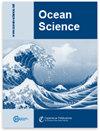Nouméa: a new multi-mission calibration and validation site for past and future altimetry missions?
IF 3.3
3区 地球科学
Q2 METEOROLOGY & ATMOSPHERIC SCIENCES
引用次数: 0
Abstract
Abstract. Today, monitoring the evolution of sea level in coastal areas is of importance, since almost 11 % of the world's population lives in low-lying areas. Reducing uncertainties in sea level estimates requires a better understanding of both altimetry measurements and local sea level dynamics. In New Caledonia, the Nouméa lagoon is an example of this challenge, as altimetry, coastal tide gauge, and vertical land motions from global navigation satellite systems (GNSSs) do not provide consistent information. The GEOCEAN-NC 2019 field campaign addresses this issue with deployments of in situ instruments in the lagoon (GNSS buoy, pressure gauge, etc.), with a particular focus on the crossover of one Jason-series track and two Sentinel-3A missions tracks. In this study, we propose a method to virtually transfer the Nouméa tide gauge at the altimetry crossover point, using in situ data from the field campaign. Following the philosophy of calibration and validation (Cal/Val) studies, we derive absolute altimeter bias time series over the entire Jason and Sentinel-3A periods. Overall, our estimated altimeter mean biases are slightly larger by 1–2 cm compared to Corsica and Bass Strait results, with inter-mission biases in line with those of Bass Strait site. Uncertainties still remain regarding the determination of our vertical datum, only constrained by the three days of the GNSS buoy deployment. With our method, we are able to re-analyse about 20 years of altimetry observations and derive a linear trend of −0.2 ± 0.1 mm yr−1 over the bias time series. Compared to previous studies, we do not find any significant uplift in the area, which is more consistent with the observations of inland permanent GNSS stations. These results support the idea of developing Cal/Val activities in the lagoon, which is already the subject of several experiments for the scientific calibration phase of the SWOT wide-swath altimetry mission.努姆萨玛:为过去和未来的测高任务提供一个新的多任务校准和验证站点?
摘要今天,监测沿海地区海平面的演变是非常重要的,因为世界上近11%的人口生活在低洼地区。减少海平面估计的不确定性需要更好地了解海拔测量和当地海平面动力学。在新喀里多尼亚,努姆萨玛泻湖就是这种挑战的一个例子,因为来自全球导航卫星系统(gnss)的高度计、沿海潮汐计和垂直陆地运动不能提供一致的信息。GEOCEAN-NC 2019现场活动通过在泻湖部署现场仪器(GNSS浮标、压力表等)来解决这一问题,特别关注一条jason系列轨道和两条sentinel - 3a任务轨道的交叉。在本研究中,我们提出了一种利用野外活动的原位数据在高程交叉点虚拟转移努姆萨玛潮汐计的方法。根据校准和验证(Cal/Val)研究的理念,我们推导了整个Jason和sentinel - 3a时期的绝对高度计偏差时间序列。总体而言,与科西嘉和巴斯海峡的结果相比,我们估计的高度计平均偏差略大1-2厘米,任务间偏差与巴斯海峡站点的结果一致。在确定垂直基准面方面仍然存在不确定性,仅受GNSS浮标部署的三天限制。利用我们的方法,我们能够重新分析大约20年的海拔观测,并在偏差时间序列上推导出−0.2±0.1 mm yr−1的线性趋势。与以往的研究相比,我们没有发现该地区有明显的隆起,这与内陆永久gnss站的观测结果更一致。这些结果支持了在泻湖中开发Cal/Valactivities的想法,这已经是SWOT广域海水测量任务科学校准阶段的几个实验的主题。
本文章由计算机程序翻译,如有差异,请以英文原文为准。
求助全文
约1分钟内获得全文
求助全文
来源期刊

Ocean Science
地学-海洋学
CiteScore
5.90
自引率
6.20%
发文量
78
审稿时长
6-12 weeks
期刊介绍:
Ocean Science (OS) is a not-for-profit international open-access scientific journal dedicated to the publication and discussion of research articles, short communications, and review papers on all aspects of ocean science: experimental, theoretical, and laboratory. The primary objective is to publish a very high-quality scientific journal with free Internet-based access for researchers and other interested people throughout the world.
Electronic submission of articles is used to keep publication costs to a minimum. The costs will be covered by a moderate per-page charge paid by the authors. The peer-review process also makes use of the Internet. It includes an 8-week online discussion period with the original submitted manuscript and all comments. If accepted, the final revised paper will be published online.
Ocean Science covers the following fields: ocean physics (i.e. ocean structure, circulation, tides, and internal waves); ocean chemistry; biological oceanography; air–sea interactions; ocean models – physical, chemical, biological, and biochemical; coastal and shelf edge processes; paleooceanography.
 求助内容:
求助内容: 应助结果提醒方式:
应助结果提醒方式:


